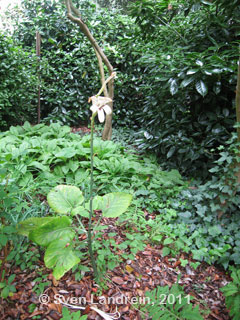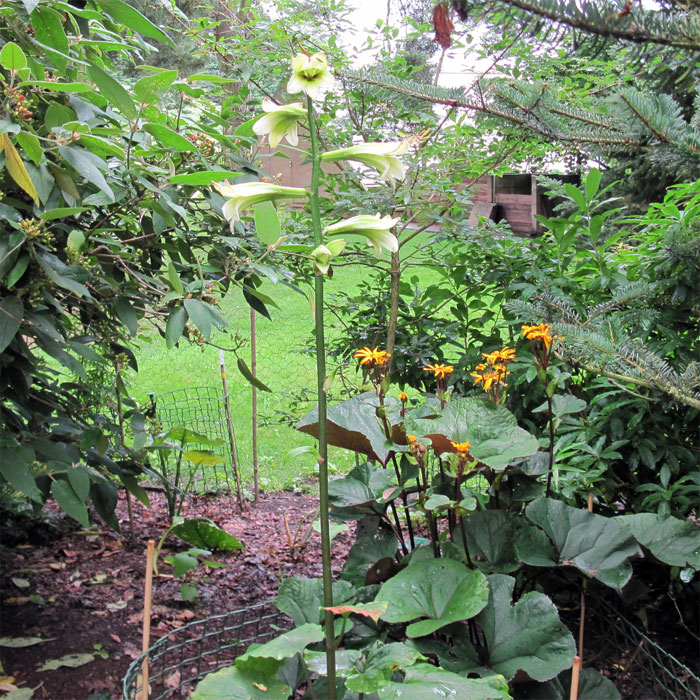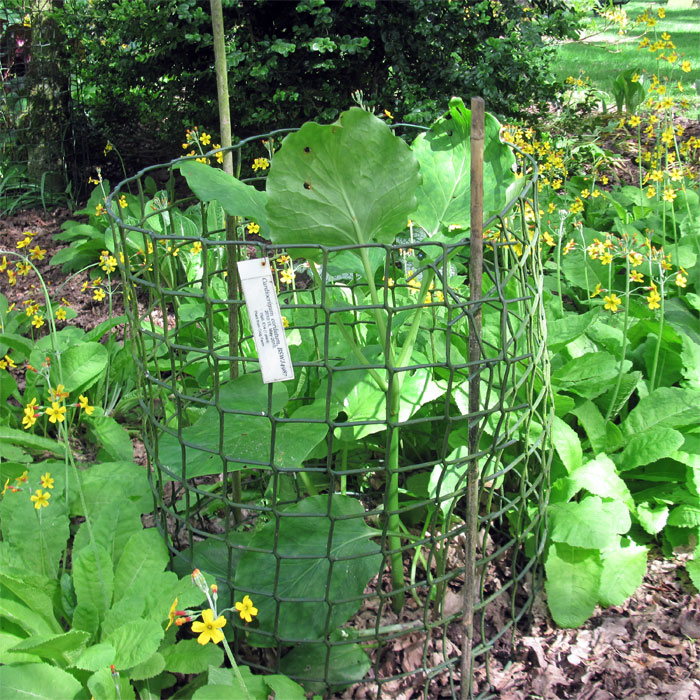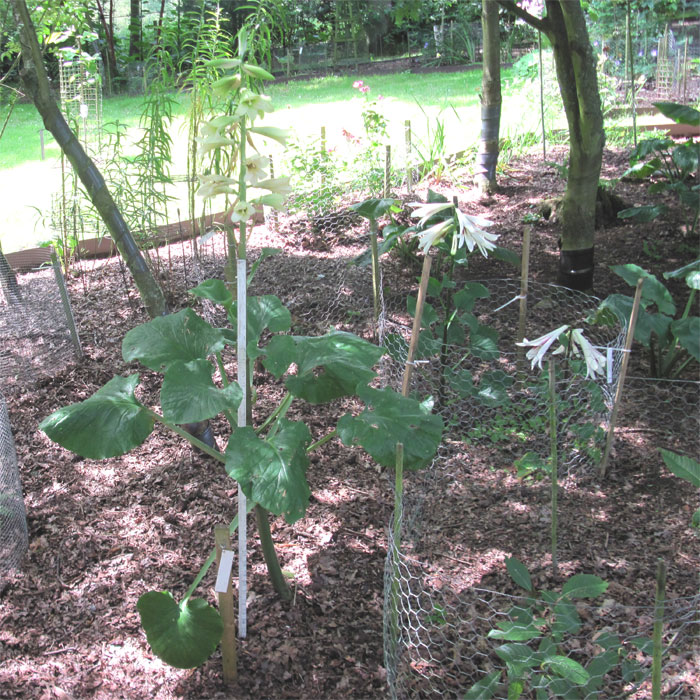In order to shed some light on the actual identity of Cardiocrinum cathayanum (hort.) and the relationship, if any, between Cardiocrinum cordatum and Cardiocrinum cathayanum, I have had DNA barcodes produced for a number of taxa in the collection.
The barcode process
The system of DNA barcodes for organisms is based on the concept of identitifying one or more genes which can be considered typical of the genus and species and using the sequencing of these genes to identify the organism. [1]
For plants, the chosen genes are the matK and rbcL genes in the chloroplast.
In general, it's not considered possible to identify taxa beyond the Species level [2] although claims have been made to differentiate C. giganteum giganteum from C. giganteum yunnanense [3]. However, this process also used the trnL-F gene sequence.
The criteria for identifying a taxa are arbitary but the following definitions, based on the work done by Meier, [5] are in frequent use. [4]
Reference Cardiocrinum barcode sequences
The BOLD[7] barcode database has nine entries for Cardiocrinum matK and rbcL genes.
This covers all three species and, in fact, all varieties except Cardiocrinum cordatum v. glehnii, but unfortunately there isn't rbcL data for C. cathayanum. This gap was filled by the good offices of the Royal Botanic Garden at Kew who extracted DNA from a descendant of Kew 2007-297[8], which was then sent for barcode sequencing along with the collection samples.
This gives the list of reference sequences shown below, (Plant, gene, source)
‡ as of January, 2015 the rbcL gene has only been sequenced for 538bp.
Comparisons were made using one or both of the online BOLD Plant sequences IDS[9] and the Align Sequences Nucleotide BLAST[10].
Comparing all possible combinations of the above gives the tables below.
| 1 | BCM | |||||||||
| 2 | 0.00 | CM | ||||||||
| 3 | 0.25 | 0.16 | ||||||||
| 4 | 0.38 | 0.40 | 0.20 | |||||||
| 5 | 0.81 | 0.56 | 0.40 | 0.64 | ||||||
| 6 | 0.75 | 0.48 | 0.26 | 0.46 | 0.24 | |||||
| 1 | 2 | 3 | 4 | 5 | 6 | |||||
| 7 | ||||||||
| 8 | 0.00 | |||||||
| 9 | 0.19 | 0.46 | ||||||
| 10 | 0.00 | 0.25 | 0.41 | |||||
| 11 | 0.00 | 0.23 | 0.37 | 0.00 | ||||
| 7 | 8 | 9 | 10 | 11 |
The values in the boxes are the p-distance. [11].
What can be understood from these comparisons is,
Collection Cardiocrinum barcode sequences
The plants from the collection chosen for the first set of sequences were, [Plant, Collection code, (Initial acquisition code)],
These were chosen to investigate the two questions referred to at the start: the nature of the plants sold to me as C. cathayanum, whose quoted identity I have reason to doubt and which I refer to as C. cathayanum (hort.), and any relationship there might be between C. cathayanum and C. cordatum.
Samples were sent to the DNA Sequencing Facility of the Natural History Museum who carried out the extraction and sequencing of the DNA of the barcode genes.[12]
As the trnL gene is mentioned as a possible species identifier[13], I also arranged to have it sequenced for the collection samples and for the material provided by Kew for C. cathayanum.
The results for C. cathayanum (hort.)
The tables below show the results of the comparisons with the samples themselves and with the reference samples.
matK genes
| 55o2 | |||
| 95o1 | 0.00 | ||
| 110p0 | 0.28 | 0.28 | |
| 55o2 | 95o1 | 110p0 |
| 55o2 | 0.85 | 0.96 | 0.57 | 0.71 | 0.00 | 0.28 |
| 95o1 | 0.85 | 0.95 | 0.56 | 0.71 | 0.00 | 0.28 |
| 110p0 | 0.73 | 0.81 | 0.49 | 0.61 | 0.27 | 0.00 |
| Ref. | 1 | 2 | 3 | 4 | 5 | 6 |
rbcL genes
| 55o2 | |||
| 95o1 | 0.00 | ||
| 110p0 | 0.18 | 0.18 | |
| 55o2 | 95o1 | 110p0 |
| 55o2 | 0.19 | 0.18 | 0.39 | 0.00 | 0.19 |
| 95o1 | 0.19 | 0.18 | 0.39 | 0.00 | 0.19 |
| 110p0 | 0.00 | 0.00 | 0.19 | 0.00 | 0.00 |
| Ref. | 7 | 8 | 9 | 10 | 11 |
trnL genes
| 55o2 | 0.74 | ||||
| 95o1 | 0.74 | 0.00 | |||
| 110p0 | 0.62 | 0.12 | 0.12 | ||
| Kew ref. | 55o2 | 95o1 | 110p0 |
Discussion
In view of the fact that all differences fall within the BCM range, no certain identification can be made on the basis of these DNA Barcodes and morphology remains the best indicator of taxonomy.
However, there are variations greater than 0.2 and these can be used to suggest the following,
I shall continue to label then as C. cathayanum (hort.), but do not intend to change my current taxonometric key which identifies them as C. giganteum yunnanense.
C. cathayanum & C. cordatum
My uncertainty about C. cathayanum is caused by the fact that the only difference I have found in the descriptions of cathayanum and cordatum is in the way the leaves are distributed along the flowering stem.


The problem with these descriptions is that C. cordatum can have the distribution described for cathayanum as shown in the pictures below.


Therefore, the possibility exists that C. cathayanum & C. cordatum are not separate species but varieties of one species and the DNA barcodes were produced to investigate this possibility.
The tables below show the results of the comparisons with the samples themselves and with reference samples of C. cathayanum and C. cordatum.
matK genes
| 15p0 | |||
| 98o2 | * | ||
| 108o3 | 0.00 | * | |
| 15p0 | 98o2 | 108o3 |
| 15p0 | 0.24 | 0.27 | 0.00 | 0.12 |
| 98o2 | * | * | * | * |
| 108o3 | 0.24 | 0.27 | 0.00 | 0.12 |
| Ref. | 1 | 2 | 3 | 4 |
rbcL genes
| 15p0 | |||
| 98o2 | 0.00 | ||
| 108o3 | 0.00 | 0.00 | |
| 15p0 | 98o2 | 108o3 |
| 15p0 | 0.00 | 0.00 |
| 98o2 | 0.00 | 0.00 |
| 108o2 | 0.00 | 0.00 |
| Ref. 7 (cathay.) | Ref. 8 (cord.) |
trnL genes
| 15p0 | 1.11 | ||||
| 98o2 | 1.11 | 0.00 | |||
| 108o3 | 1.11 | 0.00 | 0.00 | ||
| Kew ref. | 15p0 | 98o2 | 108o3 |
Discussion
Little can be deduced in the absence of a matK sequence for 98o2.
The results tend to support the conjecture that C. cathayanum and cordatum are closely related and I shall try to get barcodes from other strains of C. cordatum in future years.†
In the meantime I've altered my taxonometric key as I no longer believe that the leaf distribution can be used to distinguish C. cathayanum from cordatum. For the time being, I use the unsatisfactory, hopefully temporary criterion of 'collected location: China' to distinguish them and would be very grateful to anyone who can offer a better!
† To do list,